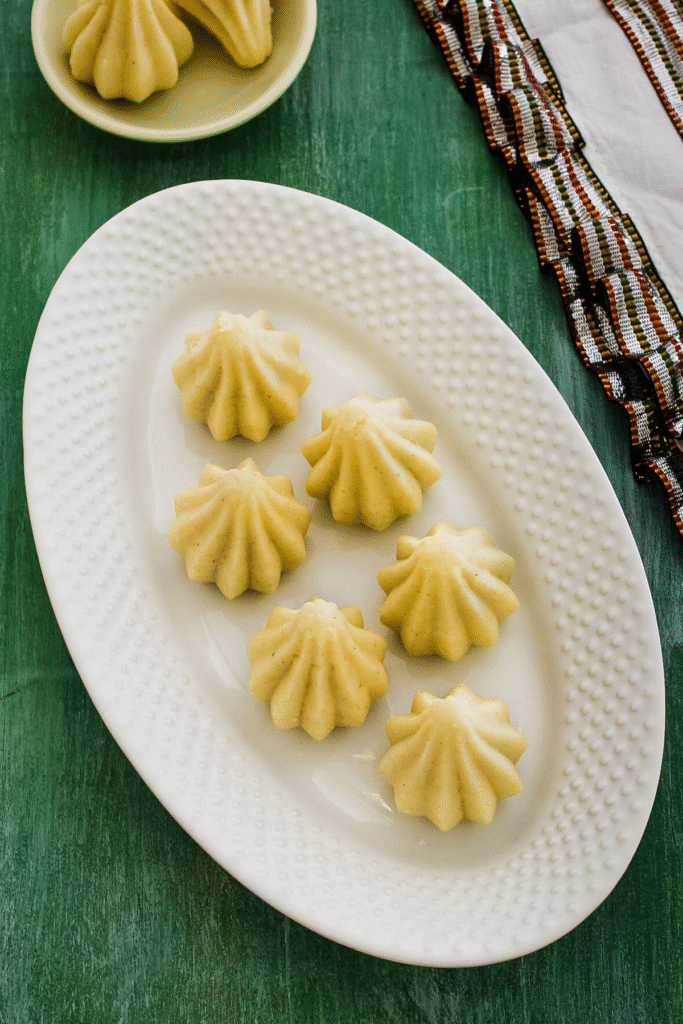If you’re looking for a festive treat that’s both easy to make and irresistibly delicious, this Rava Modak (also known as Ravyache Modak in Marathi) is the perfect recipe to try! What makes this modak special is that it doesn’t require any steaming. Yes, you read that right — it’s a non-steamed version, making it beginner-friendly and quicker to prepare during busy festive days like Ganesh Chaturthi.
These modaks have a soft and smooth outer covering made from fine semolina (rava or suji), gently cooked in milk until it forms a dough that’s pliable and melt-in-the-mouth. The inside is generously filled with a fragrant and traditional mixture of fresh coconut and jaggery, delicately flavored with cardamom and sometimes a touch of saffron or dry fruits for extra richness.
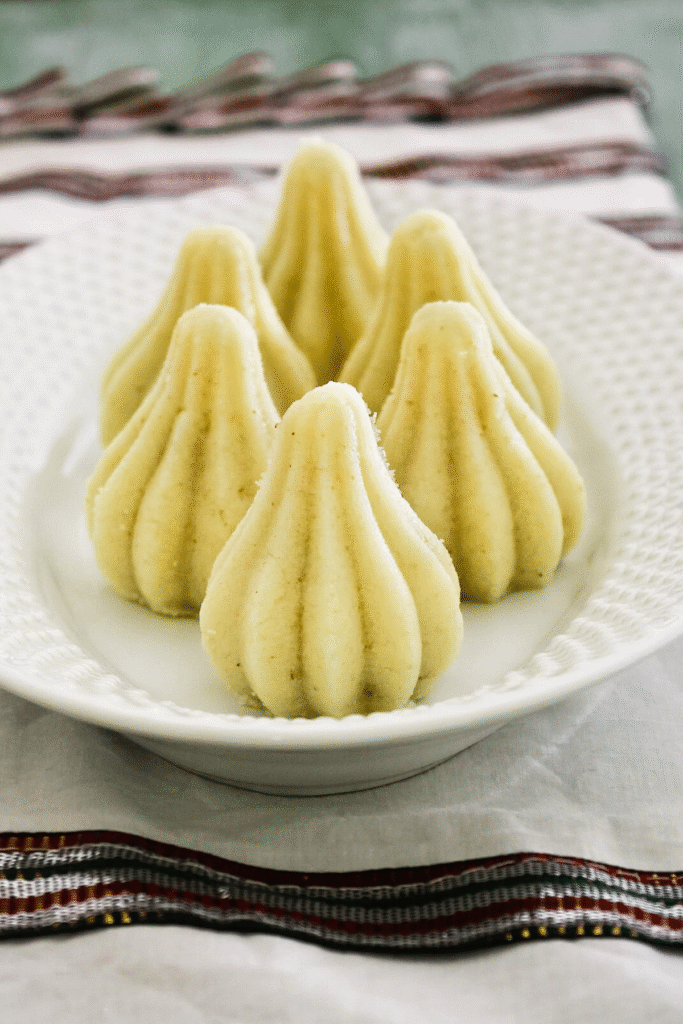
The result is a velvety modak with a delightful contrast between the slightly chewy exterior and the sweet, nutty, aromatic filling. Perfect for offering to Lord Ganesha or serving to your loved ones, these modaks are a beautiful blend of tradition and convenience.
Whether you’re someone who finds the steaming process daunting or simply want to try a new version of modak, this non-steamed Rava Modak is sure to become a festive favorite.
❤️ Make Rava Modak On Ganesh Chaturthi
- This version of Rava Modak skips the traditional steaming step, making it a quicker and simpler alternative to the classic ukadiche modak. All you need to do is prepare the soft outer dough with semolina (suji), make the coconut-jaggery filling, shape using moulds, and you’re done. No complicated steaming or advanced skills required!
- Visually, these modaks closely resemble the steamed ones, but they bring a delightful twist in texture and method. The semolina-based outer shell turns out incredibly smooth, soft, and almost melts in your mouth, just like a rich, velvety sooji halwa.
- If molding modaks by hand feels tricky, no need to stress! Let a modak mould do the hard work—perfectly shaped sweets every time with zero hassle! Modak moulds come to the rescue and make the process easy and fun, even for beginners.
- The whole process may take close to an hour, but each moment is a labor of love, infused with devotion, patience, and the joy of creating something truly special. It’s a heartfelt offering to Lord Ganesha, and one that’s sure to bring a smile to Bappa’s face.
🧾 Ingredient Notes
To prepare delicious rava modak, you only need a handful of simple ingredients—but the result is truly delightful!
For the soft and melt-in-the-mouth outer shell, gather some fine semolina (suji), milk, a splash of water, a spoonful of ghee, and a pinch of salt.
The sweet, aromatic filling is made with freshly grated coconut, jaggery, a touch of cardamom powder for warmth, a few chopped nuts, golden raisins, and a sprinkle of poppy seeds for texture and richness.
The ingredient list may be short, but the flavor is rich, festive, and utterly irresistible!
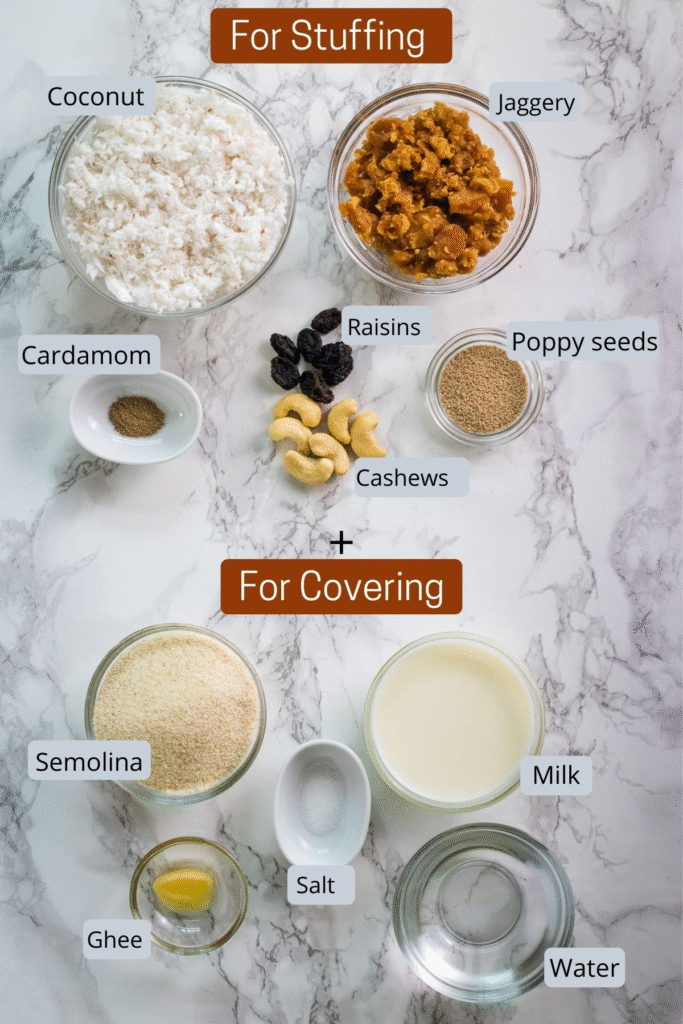
- Semolina (Suji/Rava): There are typically two types of semolina you’ll find in Indian stores—fine and coarse. For making these soft, melt-in-the-mouth rava modaks, it’s essential to use fine suji. The coarse variant is better suited for savory dishes like upma or rava uttapam, as it offers a grainier texture that doesn’t work well for modak coverings.
- Milk: This recipe is a modified version of the traditional one that uses coconut milk. However, I’ve opted for regular dairy milk because it’s more accessible and always on hand in my kitchen. Feel free to use coconut milk if you want a deeper, slightly tropical flavor.
- Coconut: I’ve used frozen, freshly grated coconut, which is readily available in the freezer aisle of most Indian grocery stores. If you don’t have access to fresh or frozen coconut, desiccated coconut can be used as a backup—just remember it will have a drier texture and slightly different flavor profile.
- Jaggery: You might notice a difference in color between the jaggery in the ingredients photo and the one used during the step-by-step preparation. That’s because jaggery can range from golden to deep brown in color. The final hue of your filling will vary depending on the type of jaggery you use. You can use either jaggery powder or grate a solid block for use.
- Jaggery Substitution: If jaggery isn’t available, you can swap it with brown sugar—either light or dark. Dark brown sugar will give a richer color and more molasses-like depth, similar to dark jaggery.
- Poppy Seeds (Khuskhus): This is an optional ingredient that adds a lovely texture and nutty undertone to the filling. We’re talking about Indian white poppy seeds here—not the black kind sprinkled on bagels. White poppy seeds are called khuskhus and are used in traditional Indian sweets and curries.
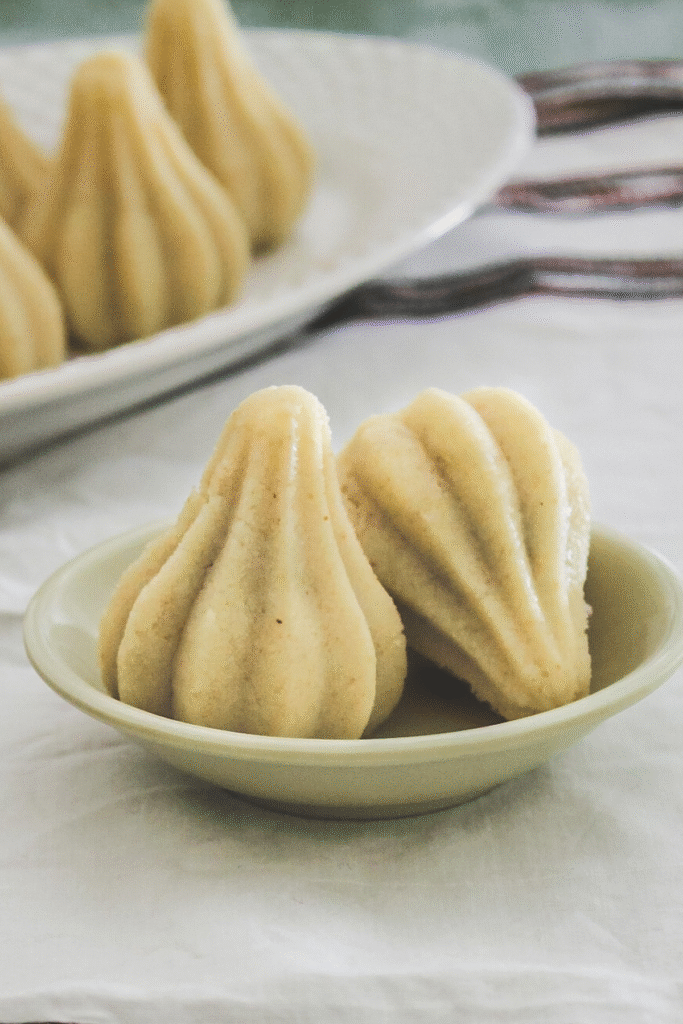
👩🍳 How To Make Rava Modak Recipe? (Pics)
Make Stuffing:
1) Place a pan on medium heat and toss in the freshly grated coconut followed by the crumbled jaggery. Let the natural sweetness begin to melt and mingle, releasing a warm, caramelized aroma. Stir to mix well as the jaggery begins to melt and coat the coconut evenly.
2) Stir continuously as the jaggery begins to melt, turning into a syrupy consistency. Keep cooking, allowing the mixture to thicken and the excess moisture to evaporate. This typically takes 6–7 minutes, but may vary based on how moist the coconut is or how soft the jaggery was. Keep a close watch to prevent overcooking.
3) Once thickened, stir in the poppy seeds, chopped cashews, raisins, and a pinch of cardamom powder for aroma and flavor.
4) Cook for another minute, just until everything is well combined. Then turn off the heat and transfer the mixture to a plate. Let the mixture cool down fully before using it as a stuffing.
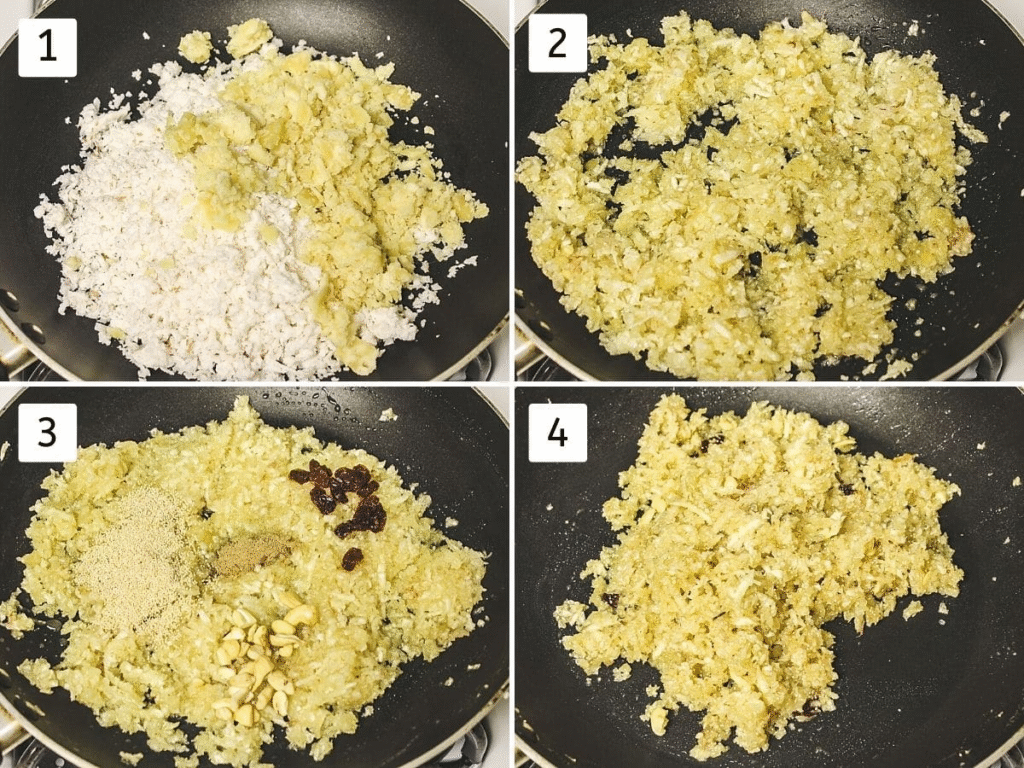
Make Outer Layer Dough:
5) Heat a heavy-bottomed pan and add semolina. Begin dry roasting over medium-low heat, stirring constantly. Roast it until it turns slightly aromatic and starts showing a light golden hue—this usually takes about 7–8 minutes.
6) Transfer the roasted semolina to a plate and let it cool for a few minutes. Set it aside.

7) In a separate pan, combine water and milk, then gently whisk in the ghee. Place the pan over medium heat and allow the mixture to warm up, letting the ghee melt and infuse its rich aroma throughout the liquid. Set the saucepan over medium heat, allowing the mixture to warm up gently as the ghee begins to melt and infuse the liquid with rich flavor. Allow it to come to a gentle boil.
8) As soon as the milk mixture begins to simmer and tiny bubbles rise to the surface, swiftly stir in the roasted semolina to lock in the warmth and aroma. Stir briskly to prevent any lumps from forming.
9) The mixture will quickly turn thick and resemble a soft, sticky mass.
10) Keep stirring and cooking the mixture until it thickens, starts to come together, and pulls away cleanly from the sides of the pan, forming a soft, pliable dough.
11) Transfer the dough onto a plate and allow it to cool just enough to handle—warm but not hot. As soon as it’s comfortable to touch, begin kneading it into a smooth and tight dough ball.
12) Avoid letting the mixture cool completely before kneading, as it can turn dry and crumbly, making it difficult to work with. If it feels too warm, dip your hands in water as needed while kneading to manage the heat.
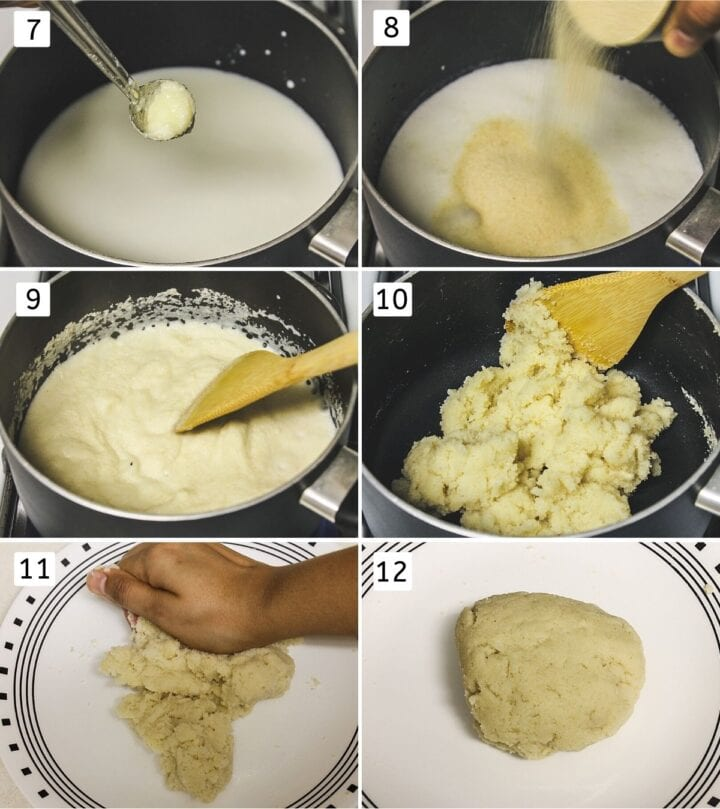
Shaping The Suji Modak:
13) Lightly grease the inside of the modak mould with a little ghee to prevent sticking. Keep the mould nearby for easy access. Take a small portion of the prepared semolina dough and roll it into a smooth ball. Gently insert this ball into the mould from the bottom opening.
14) Using your fingers, press the dough along the walls of the mould, spreading it out evenly to form a thin, smooth shell. Be sure to create a hollow space in the center for the filling.
15) Spoon in the coconut-jaggery stuffing into the hollow center you just created, filling it generously without overpacking.
16) Take a tiny amount of dough and use it to seal the open base of the mould. Press and smooth it carefully so the filling doesn’t leak out and the base is even and flat. Make sure the modak is sealed completely.
17) Now, gently open the mould without tugging. Do this with care to maintain the shape.
18) Carefully unmould the shaped modak and place it on a greased plate. Keep shaping modaks using the remaining dough and filling, following the same steps each time. Continue until all the mixture is used up and each modak is perfectly crafted and ready to be steamed to perfection.
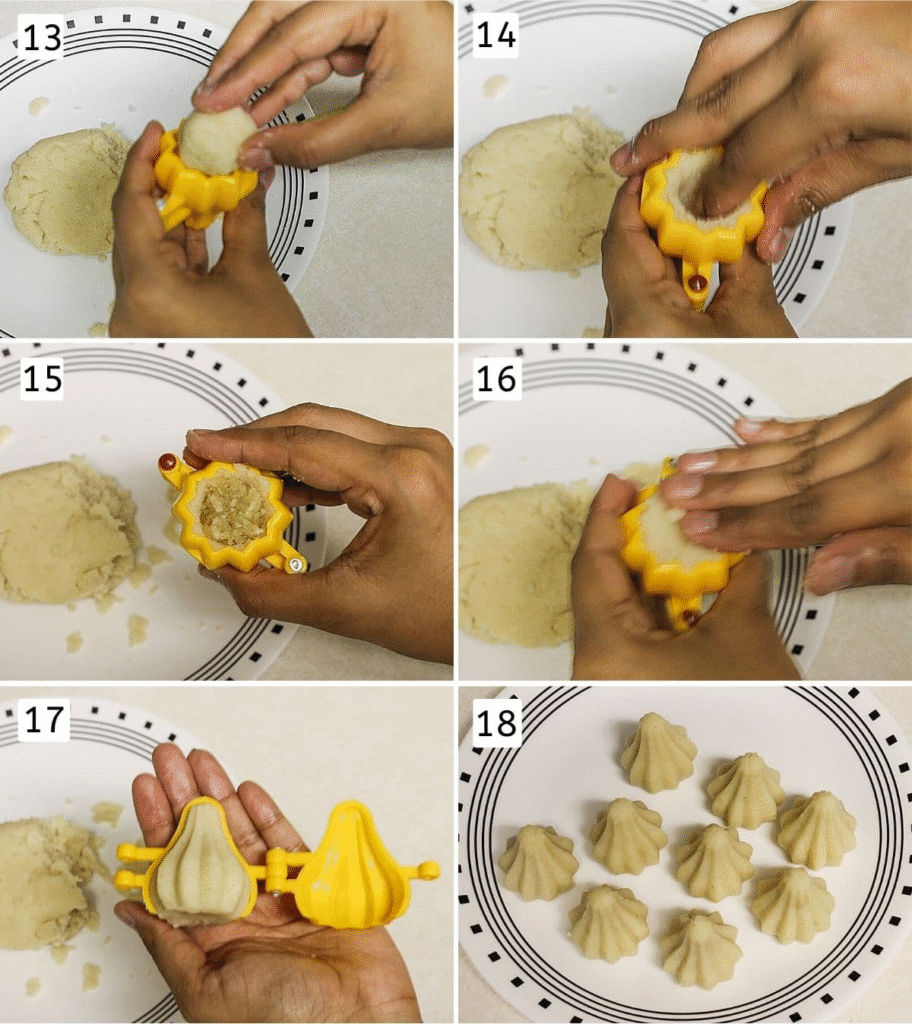
💭 Expert Tips For Rava Modak
- Avoid Overcooking the Filling: Keep a close eye on the coconut-jaggery mixture while cooking. Overcooking can cause it to become dry and chewy instead of soft and flavorful.
- Knead the Dough While Warm: Don’t wait for the dough to cool completely. Begin kneading while it’s still hot or warm. To make it easier, dip your hands in water before handling—this helps avoid any discomfort from the heat and gives you a smooth dough.
- Evenly Shape the Outer Layer: When molding the modak, press the dough gently and uniformly around the cavity. This ensures each bite has a balanced ratio of filling and outer covering. Uneven thickness may result in bites that are either too doughy or lack stuffing.
- Customize the Filling: For a simpler version, feel free to skip the poppy seeds, cashews, and raisins. A basic mix of fresh coconut and jaggery still makes a delicious, traditional filling.
